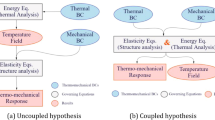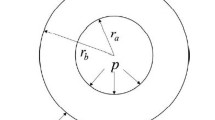Abstract
The maximum compound stress in the thick wall cylinder is usually the key factor that causes the thick wall cylinder to crack. The existing calculation method for stress–strain under thermo-mechanical impact in thick wall cylinder is suitable for stress analysis in the thermo-elastic range. However, the compound stress of the thick wall cylinder under the thermoplastic condition cannot be well analyzed. In this paper, a method to calculate the compound stress of the thick wall cylinder under the effect of thermal–mechanical impact is proposed, based on the finite difference method and the ideal elastic–plastic model and the Mises yield criterion. This method solves the problem of the compound stress calculation to the tube wall under the thermoplastic condition, which change as a result of the combined effect of thermo-mechanical impact. The compound stress in the wall close to the bore surface at different times during shooting is calculated, taking the firing process of a gun as an example. The calculation results well explain the cause of the formation of the crack and the distribution characteristics of the crack in the bore surface.














Similar content being viewed by others
References
Underwood, J., Parker, A.: Fatigue Life Analysis and Tests for Thick-walled Cylinders Including Effects of Overstrain and Axial Grooves. US Army Armament Research, Development and Engineering Center, Watervliet (1994)
UnderWood, J., Audino, M.: Army Cannon Fatigue Life Evaluatin: Crack Initation, Fracture Mechanics, and NDI. US Army Armament Research, Development and Engineering Center, New York (1996)
De-Lin, M.: Barrel stress intensity factor. Ordnance Mat. Sci. Eng. 1987, 19–27 (1987). (in chinese)
Hong-nian, C., Xu-cheng, Z., Bing-ye, X.: The Technics of Autofrettaged Gun Tube. National Defence Industry Press, Beijing (1997). (in chinese)
Zhi-Qi, Y.: Study of 720 high strength and high toughness of thick wall steel. High pressure gun system papers. National Defence Industry Press, Beijing (1986)
Zhen-jie, H.: Analysis on Thermo Elastic Coupling of Gun Barrel in the Process of Firing. Nanjing University of Science and Technology, Nanjing (2007). (in chinese)
Zhong-Ren, W., Shi-Jian, F., Lian-Xi, H.: Fundamentals of Elasticity and Plasticity, 2nd edn. Harbin Institute of Technology Press, Harbin (2007). (in chinese)
Shelton, S.: Study of Heat Transfer and Erosion in Gun Barrels. Air Force Armament Laboratory, Florida (1973)
Lin-fang, Q.: Gun Ballistics. Institute of Technology Press, Beijing (2009). (in chinese)
Boisson, D., Coyzac, R., Legreat, G.: Study of the gas discharge and the heat exchanges occurring in a gun barrel after the projective leaves the barrel validation for the 30 mm gun. In: Proceedings of 18th International Symposium on Ballistics, p. 207 (1999)
Zhen-qiang, L., Tao, W., Shi-hai, Y.: Weapons Gas Dynamic Numerical Calculation Method. National Defence Industry Press, Beijing (2005). (in chinese)
Zhen-xing, H., Ping, W.: Encyclopedia of Fluid Mechanics. Beijing University of Aeronautics and Astronautics Press, Beijing (1991). (in chinese)
Incropera, F.: Fundamentals of Heat and Mass Transfer. Wiley, New York (2007)
Li, J., Li, F.: Advanced Heat Transfer. Higher Education Press, Beijing (2003). (in chinese)
Bing-ye, X., Xin-sheng, L.: Application of elastic-plastic mechanics, 1st edn. Tsinghua University Press, Beijing (1993). (in chinese)
Yun-gui, S., Shu-tian, Z.: Artillery metallograph-Microstructure. National Defence Industry Press, Beijing (1986). (in chinese)
Metals Asf.: Phase transformations. In: Papers Presented at a Seminar of the American Society for Metals Chapman&Hall Ltd (1970)
Porter, D., Easterling, K.: Transformations in Metals and Alloys. Taylor & Francis Group, Abington (2009)
Parker, A.: Stress Intensity and Fatigue Crack Growth in Multiply-cracked, Pressurized, Partially Autofrettaged Thick Cylinders. Army Materials and Mechanics Research Center, Watertown (1981)
Author information
Authors and Affiliations
Corresponding author
Rights and permissions
About this article
Cite this article
Lin, G., Ming, L., Feng-he, T. et al. A simplified method for calculating surface stress of thick walled cylinder based on numerical calculation method. Cluster Comput 22 (Suppl 3), 6471–6482 (2019). https://doi.org/10.1007/s10586-018-2248-2
Received:
Revised:
Accepted:
Published:
Issue Date:
DOI: https://doi.org/10.1007/s10586-018-2248-2




